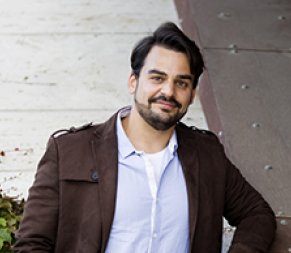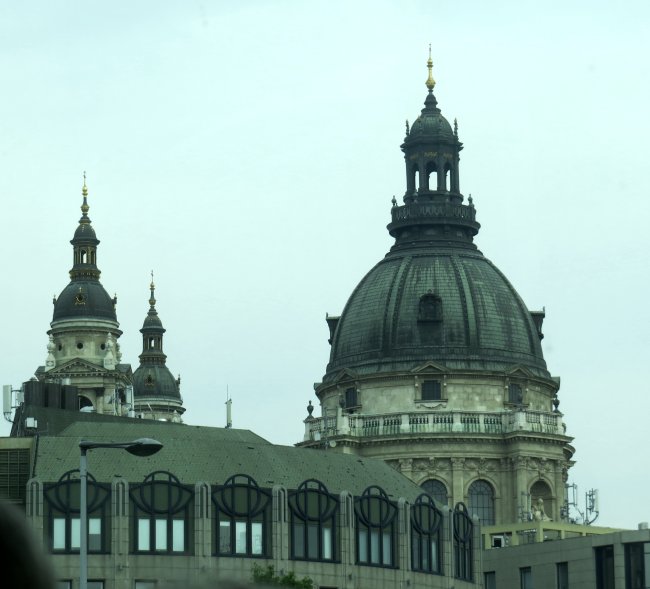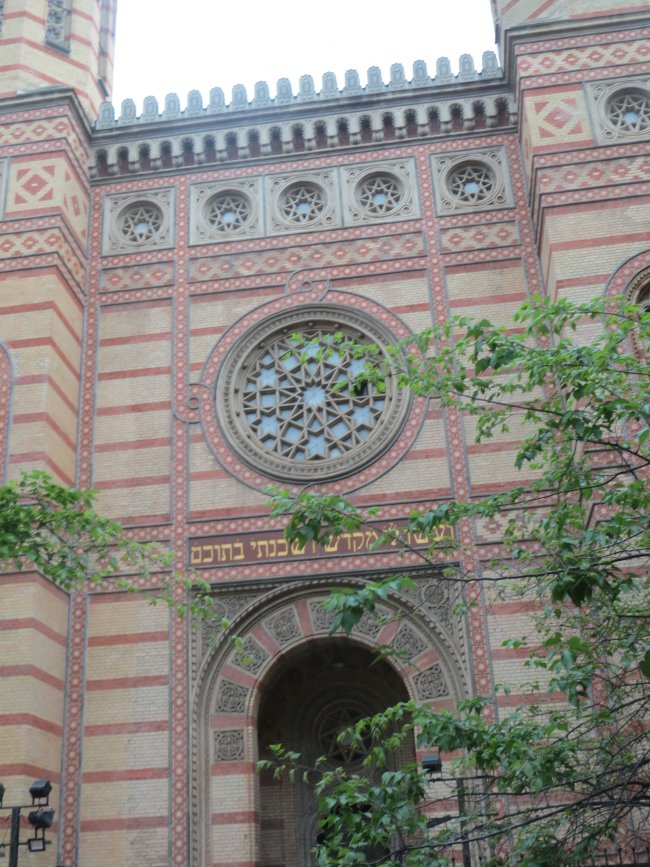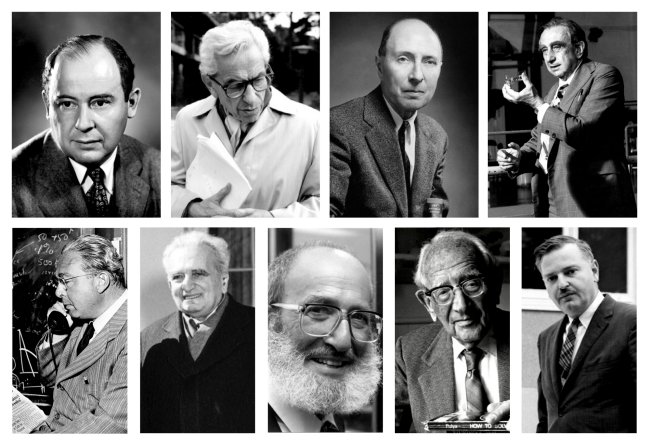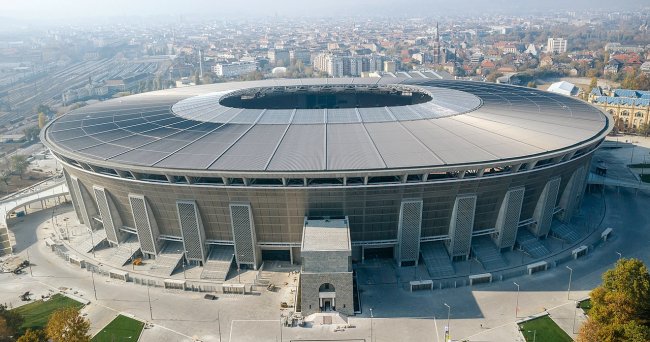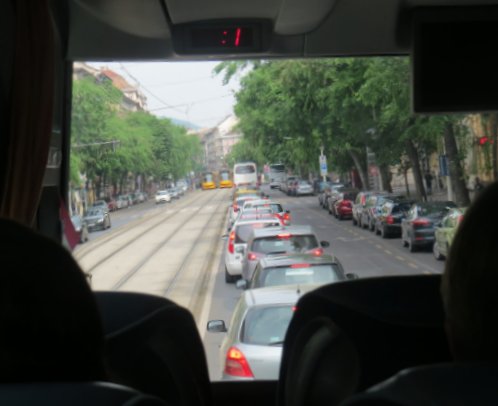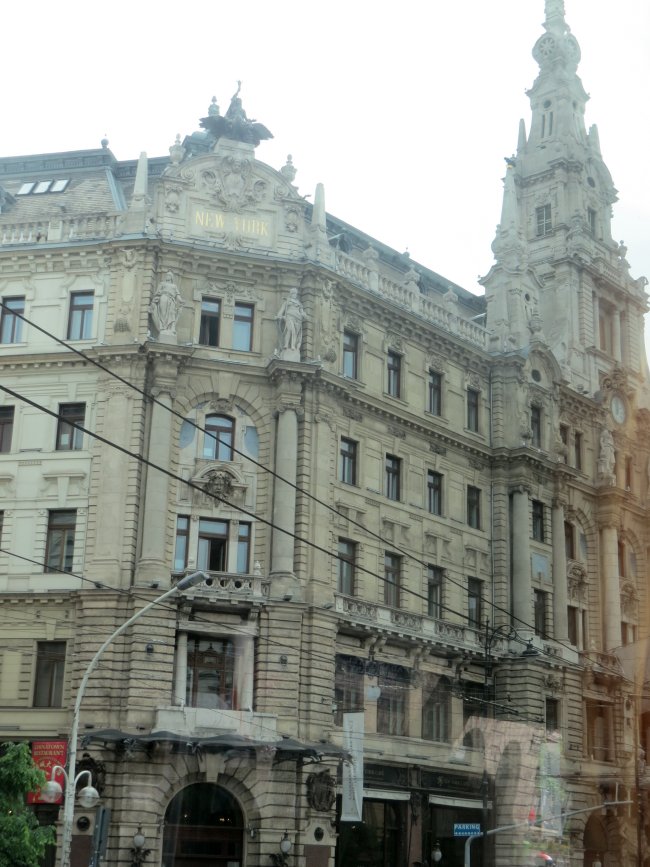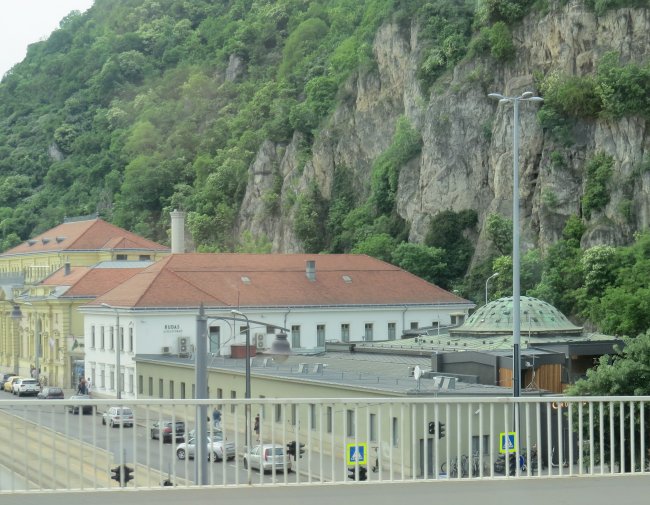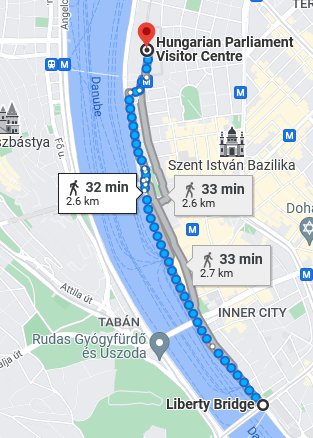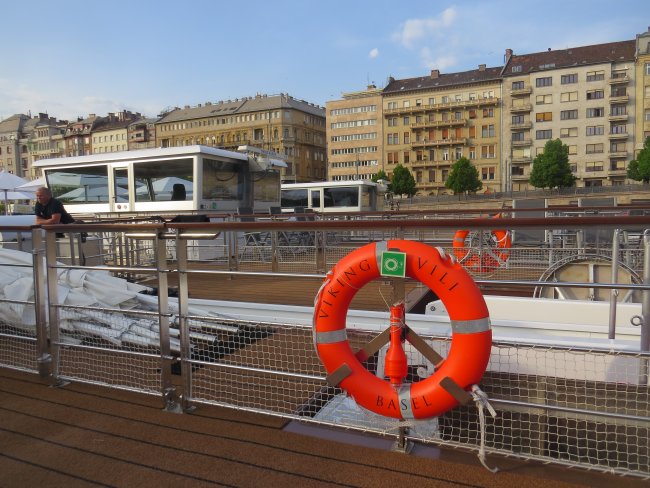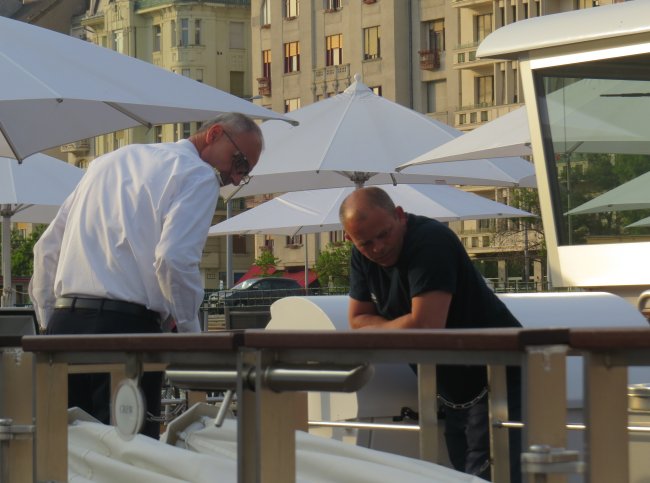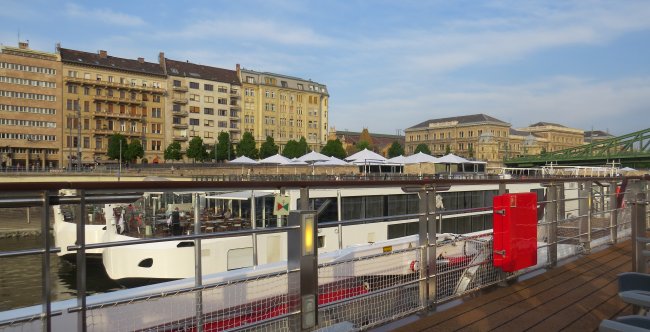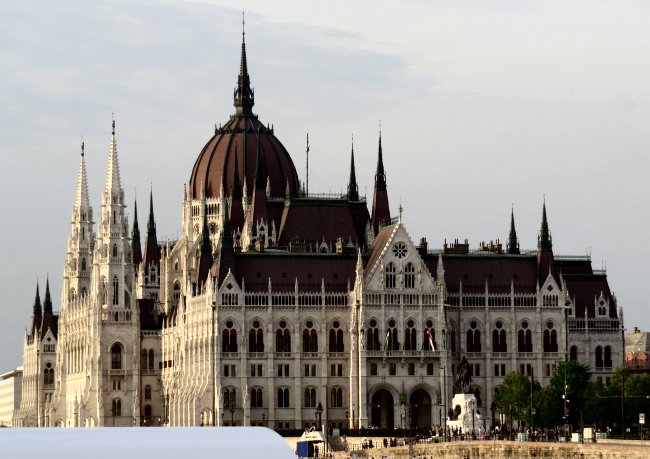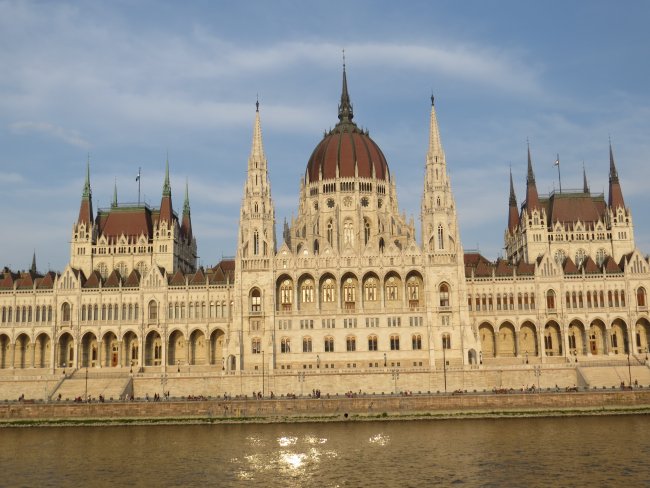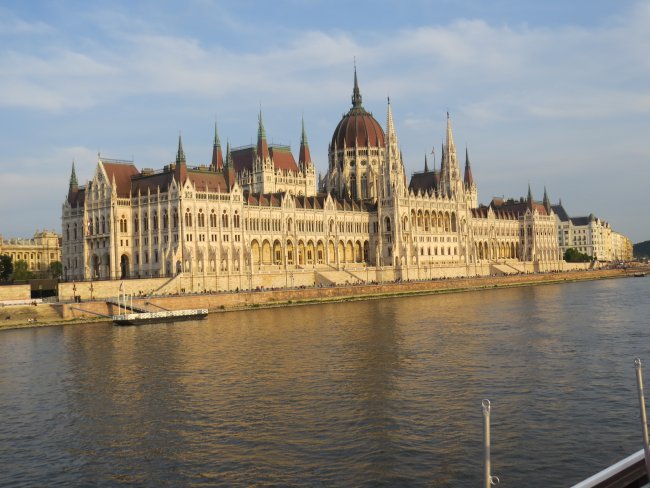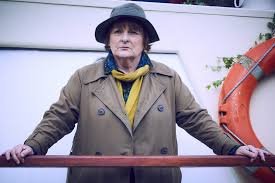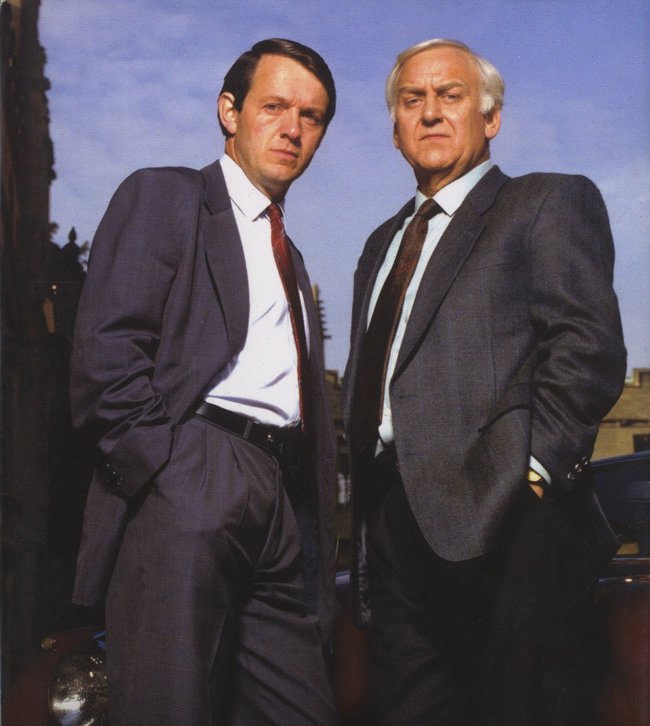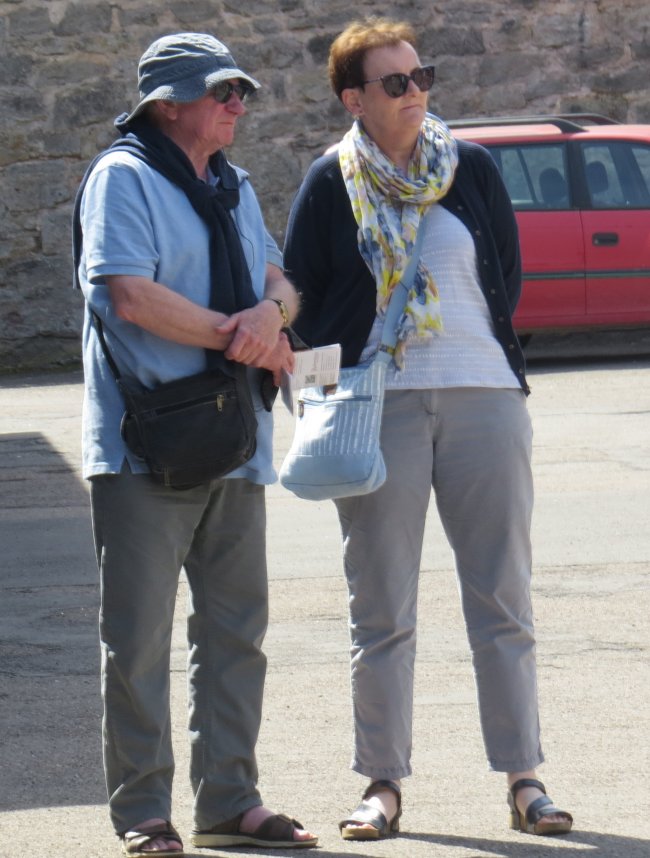Before the excursion: In many ways this day was a dud, in fact a painful bloody dud. In the end, however, it exemplified the fact that the great moments in vacations often seem to appear at the most unexpected times.
The plan for the first real day of the vacation had only two elements. I planned to take the morning excursion simply because it was free. I had been to Budapest before, and I really had little need for an orientation for the city and a feel for the history and people of Hungary. In the afternoon I planned to walk to the Parliament building and take a tour. I had already purchased a ticket online and downloaded it to my cellphone.
I tumbled out of bed at about 6:30 and checked the forecast on Weather.com. It appeared to be ideal—mostly sunny with a high of around 70 and almost no chance of rain.
Every day on the ship began with the saliva-based Covid test. I dutifully filled up the tube, inserted it into the envelope that contained my name and room number, and dropped it off at the reception desk.

Viking provided every stateroom two European-style FFP2 masks. The straps looped around the ears. In some ways they were more comfortable than the N95 masks that I had brought, but wearing them for several hours bothered my ears. The biggest problem was that the straps on three of them broke during the course of the voyage. I was, however, able to obtain replacements at the reception desk.
Breakfast on the Viking Vili was what you made of it. Passengers could ask chef Roberto Calungsod to prepare almost any kind of eggs or pancakes or French toast. They could ask a waiter to bring them something. The alternative was to help themselves to the buffet. Breakfast has never been an important occasion for me; I chose the buffet every day. I selected scrambled eggs, sausage, bacon, thinly sliced ham, and a potato patty, a routine that I repeated thirteen times with only slight variations. A waiter brought coffee and fruit juices. I alternated between orange juice and tomato juice.
I selected a seat by the window at an empty table. No one joined me. This did not bother me too much. Meals were a dangerous time in 2022, but all of the waiters—and all of the other Viking employees—always wore masks. So, by sitting alone in the restaurant I was probably safer than anyone else who dined there.
After breakfast I brushed my teeth and lay down for a few minutes. I then gathered together my equipment—camera, recorder, QuietVox, excursion ticket, and key card for the stateroom[1]— and proceeded to the Guest Services area for the "Panoramic Budapest" tour. This was the first time this century that I had done any kind of tour without a spiral notebook and pen. I figured that if I needed to make a note of something, I could speak it into the recorder like Bill Blazejowski in Night Shift.
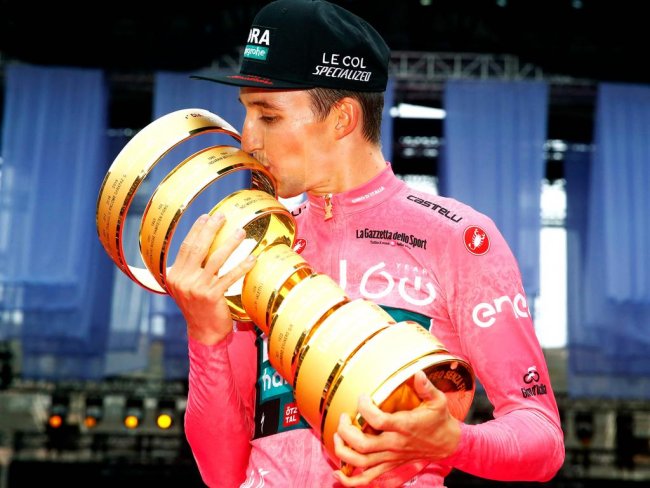
The Giro d'Italia: For some reason the first three stages of the Italian international bike race, the Giro d'Italia, were schedule to be held in Hungary. This was "only" the fourteenth time that La Grande Partenza of the annual event was held outside of the Italian peninsula.
The first stage was held on Friday, the day that I landed in Budapest and boarded the Viking Vili. That race began in Budapest at noon and ended in Viségrad, 195 kilometers to the east. So, it had little or no effect on the cruise.
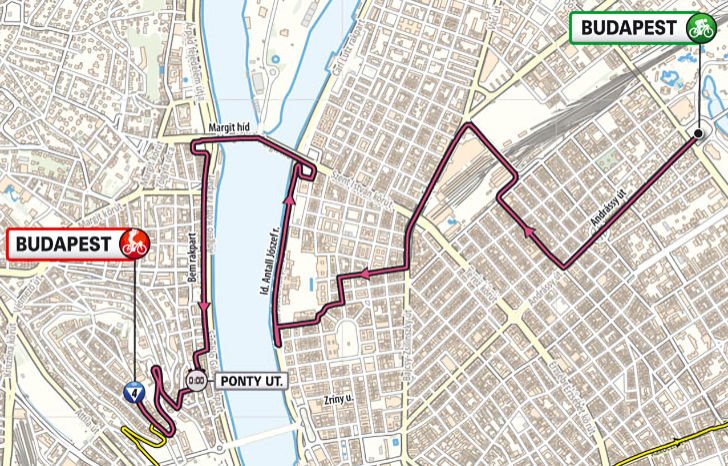
The race on Saturday, however, was an ITT, an individual time trial, which was a much shorter stage than most. It emphasized speed rather than endurance. Furthermore, it was held entirely within the city of Budapest, and its route largely coincided with the most popular tourist attractions. The time trials usually attract very large crowds of viewers along the routes, and the one on Saturday was no exception. I was pretty sure that the event accounted for the large number of athletic guys that were on the Helvetic flight from Zurich. Since the race started on Friday, they must have have been fans or wannabes, not participants.
Originally the ITT was scheduled for Stage 1. At some point, it was moved to Stage 2, probably in the hopes of drawing larger crowds on a weekend. The company that Viking hired to run the bus tour clearly thought that the race, which did not actually start until 2:00 in the afternoon, would not interfere with the route that had been agreed upon. Their conclusion was wrong.
The "Panoramic Budapest" excursion: We assembled for the excursion at approximately 8:30. We were scheduled to return to the ship at 12:30. By chance Gary Nicholson, the ship's Program Director, rode on the same bus that I did. He told us about the bike race. He also said that we would not need the QuietVoxes. I put mine in my pocket.
When I set out to write this page, I could remember embarrassingly little about the bus ride. Fortunately, I recorded the first hour and twenty-one minutes of it. It was too boring to include, but I listened to all of it and used it for the rest of this section.
Here is a summary of what I found on the recording:
Our tour guide's name was István (ISHT vahn) Gregor. Hungarians generally place the family name first: Gregor István. He said that we could call him Steve. The driver's name was András ("s" in Hungarian is pronounced like "sh" in English).
For the first half hour or so, we encountered very little traffic. István spoke to us over the intercom system. He began his presentation with "Okey-dokey". One of the first things that he disclosed was that the bicycle race was on the Buda (west) side of the Danube. I don't know where he got that idea.
His English was good for the most part, but sometimes it was a little difficult to understand what he was saying. He described his accent as "Hungrish".
The plan was for us to drive near the Jewish synagogue (which he pronounce with a long o, as in "rogue"), and we did. He also said that we would drive through the famous Andrassy Avenue, but, for reasons that will soon be clear, we did not.
From the bus we could see the Gellért (Hungarian form of Gerard) hotel and spa on the Buda side across the Liberty Bridge. The bridge was built in 1896.
As we drove past the Grand Market, which was built in 1897, István told us that Hungary was a relatively flat country with no real mountains. The highest elevation is only 1,000 meters.
In 1838 there was a big flood. The Danube destroyed 90% of the buildings in Pest. The central city area of Pest now had expensive apartments that mostly were in the upper floors of buildings that were erected after the flood.
In World War II Hungary allied with the Nazis in 1940. In March, 1944, German forces occupied Hungary. After the Nazis withdrew from Russia following the disaster at Stalingrad, Soviet troops entered Hungary. Budapest was effectively placed under siege by the Russians in December of 1944. Most buildings that were destroyed during the siege were restored after the war with the same façades.
We drove past the Hungarian National Museum. István told us that his field of study was archeological history. He specialized in the Middle Ages. He invited questions about archeology or history, but no one ventured one.
István, who lived on the Pest side, reported that people in Pest often referred to Buda as the "snobbish" side. About 1.7 million people resided in Budapest, with about another 300,00 in the suburbs. Hungary had about 10 million citizens all together. The total area of the country was roughly equivalent to Ireland or Indiana. Hungary was a member of both the European Union and NATO.
István warned us that Hungarian was a complicated language. The alphabet contained 44 letters. It was probably not worth the effort to learn it. The only place in the world that the language was spoken was Hungary.
As we drove past "Jewish town", István pointed out the synagogue. At some point we were on Market Street, which would lead to the Grand Market, the last stop on the excursion. Evidently all kinds of things were for sale there, and one could pay with dollars, euros, or credit cards.
By this time the traffic was pretty heavy. István directed our attention to Elizabeth Park (Erzsébet tér) on the right. Unfortunately, I was seated on the left side. We also saw the dome of St. Stephen's cathedral.
I could hear paper rustling as István looked through his notes to find something that he could use to fill up the time while the bus was inching along. He told us that the Pest side was very walkable, and the whole city had a good system of trams (streetcars) and buses. He gave us the numbers of the main routes. Since I had no intention of using them in the few hours of free time that we had in the afternoon, I made no note of them.
The Dohány Street Synagogue was built in the 1850's. It was the largest synagogue in Europe. On its grounds was the Holocaust Memory Park. The spires were 46 meter high. In 1996 Tony Curtis, whose parents were Jewish Hungarians, helped pay for the reconstruction of the synagogue.
Bela Lugosi was born in Budapest.
The founder of the nation of Hungary and its greatest hero was King Stephen I. István was a common name, his surname, Gregor, was not. Only two other people in all of Hungary were named Gregor.
The Hungarians originally resided in an area near the Ural Mountains. They were nomadic pagans who lived in tents. They fought as mounted archers. They settled in Hungary in the late ninth century. King Stephen unified them and created a Christian nation. There was a traditional story that the Archangel Gabriel gave a crown to Stephen. That crown was allegedly the one on display in Parliament. On our last trip here we heard that Stephen was crowned by "the pope" in 1000. The two stories were equally unlikely. Sylvester III, who was pontiff in 1000, never left Italy.
We drove past the largest train station in Hungary, the Keleti or Eastern Station. It was constructed in the late nineteenth century. At the time Budapest was one of the centers of the Austro-Hungarian empire.
The football (soccer to you) stadium in Budapest, Puskás Aréna, was quite modern, but, according to István, the team was very bad. The stadium was named after Ferenc Puskás, Hungary's greatest soccer player. In the 1950's he left Hungary to play for Real Madrid, where he was known as Pancho. Puskás was a hero in both Hungary and Spain. He won some award for the most spectacular goal.
István said that we would be taking Stefánia road to Andrassy Avenue, and, indeed we were in line for a long time to make the turn.
István described some buildings that we passed as having something to do with geology. He then said, "Oh, yeah, science," and retrieved his notes about famous Hungarian scientists.
- László Bíró, a journalist, patented the first commercially successful ballpoint pen, which he patented in 1928.
- Ernő Rubik invented the Magic Cube in 1977. It was marketed with his name in the eighties.
- In the forties, because of the Nazis, many scientists left Hungary, journeyed to the U.S., and joined the the Manhattan project. They were called the "Aliens from Mars" because their language sounded unearthly. Their number included Edward Teller, John van Neumann, and many others.
- István declared that he wanted to tell us a story. In 1956 a Hungarian teenager[2] immigrated to the United States, where he went to work for General Motors. He was assigned to work on the Apollo Project. He was the principal designer of three lunar rovers. He currently had retired and was living in Santa Barbara, CA. His name was Ferenz Pavlics.
István said something about a geodome, but I did not understand what he was referring to.
We received a short language lesson in Hungarian:
| English | Hungarian | Pronunciation |
| hello | szia | SEE ah |
| thank you | köszönöm/köszi | kur SEE |
| beer | sör | SHUR |
| wine | bor | BOR |
| cheers | Egészségére | egg eh SHEG eh r(trilled)eh |
| Hungarian schnapps | pálinkát | PAH leen kaht |
| police | rendőrség | REN dor sheg |
A lady in the tour group asked about a particular flowering tree. István said that he was not a botanist. He did not know what kind of tree it was. He did say that it would not be found in a Hungarian forest. The most common varieties of trees in Hungarian forests were beech, oak, acacia, and horse chestnut. He mentioned acacias several times.
During all of this time the bus was barely moving forward. István said that parking was difficult in Budapest. The Communists planned for everyone to live in apartment towers and to travel on buses and trams. In the twenty-first century, however, many Hungarians owned cars.
István reiterated that you could pay at the Grand Market using dollars, euros, or credit cards. Hungary was still using forints because its economy was too weak to convert to the euro. At the time one euro was worth 384 forints. One thousand forints equaled roughly $3. ATM machines were labeled. "HUF" meant that the machine distributed Hungarian forints. ATMs labeled "EUR & HUF" would disperse either euros or forints. He claimed that in Budapest most stores accepted euros as payment.
I think that our bus was on Grand Boulevard. András tried to turn so that we could drive on Andrassy Avenue. The policeman would not allow him to turn left. András was upset that he allowed a taxi to do it.
As the bus was forced to maneuver through roads that were not on our original itinerary István texted to other guides that Andrassy Avenue was closed.
As we passed the New York Cafe István told us that it was the most beautiful one in Budapest.
Our new route took us toward the Liberty Bridge, which István considered the most beautiful. He also told us that the Chain Bridge, which had been constructed in 1849, was currently being repaired.
We made a very quick trip to the Buda side. There we could see the Rudas Turkish baths. István said that they were 500 years old, but Wikipedia claims they had been built in 1550. There was a dome over the building. From the Jacuzzi on the top the view was supposed to be terrific.
The bus then went back to the ship. We could get off or stay on for a trip to the market. It was not yet 10:30! I had no interest in the market.[3] I boarded the ship, scanned in my key card, and went down the stairs to room #100 to plan my strategy for the afternoon.
The bus tour was certainly a disappointment for most people. A drive down Andrassy Avenue on a typical Saturday morning would have been much more pleasant than what we experienced. I got almost nothing out of this excursion, and I would have gotten much less without my recorder. However, I had low expectations, and I had already seen most of what we missed on my previous trip to Budapest, which has been documented here.
Between tours: I started up my laptop and checked my email. Then I created folders for each remaining day of the trip. In each folder I created a sub-folder for mp3 files. I also uploaded all of my photos from the morning to the folder for day 2. Then I lay down for a few minutes.
One thing that I had definitely learned during the excursion was that the ship was NOT docked near the Chain Bridge. It was very close to the Liberty Bridge, which Google Maps estimated was at least a thirty-two minute walk from Parliament. If the tour started at 4:00 and lasted for an hour, the soonest that I could be back was 5:32, which was slightly later than the officially posted required time.
I had expected that time to be later than 6:00—the return time of the "Hungarian Icons" excursion that was described on the last version of the "My Viking Journey" website. However, when I checked the Viking Daily I found no mention of this tour. It must have been canceled.
I refused to take any chance of missing the ship. I needed more information. I generally walk at a fairly brisk pace. Perhaps I could make the walk in less than thirty minutes, or maybe I could duck out of the tour a few minutes early.
Because the ship was cashless, anyone wanting to purchase anything needed to register a credit card at the Guest Services desk. I decided that I wanted to purchase two excursions that required bus rides, "Rothenburg ob der Tauber" and "Modern Aristocracy". On the way to lunch I registered my Bank of America Mastercard for the purpose of ordering these two excursions.
I ate lunch alone. I ordered roast veal, which came with potatoes and something orange, probably carrots. It was very good. For dessert I selected the fruit cup. I ate rather rapidly because I was eager to determine whether it was feasible to take the 4:00 tour of the Parliament and still return to the ship on time.
I noticed during my repast that the ship was slowly moving. At times it was even moving backwards! There were six Viking ships in port on May 7, 2022, but they occupied only two docking slots. They were triple-parked. During lunch the ships rearranged themselves so that Viking Vili had two other ships between it and the shore. During this unannounced maneuver all of the passengers were trapped on the ship. We were not released until after 1:30.
In a sense this made me happy. My hunch that I might not be able to make it to the 2:00 tour of the Parliament after the morning excursion had proven to be correct. If I had bought a ticket for that tour, I would really have been upset that I was not allowed to leave the ship.
Even so, the wait flustered me, or at least that was my excuse for what happened (and didn't happen) in the next hour or so.
The visit to Parliament: The Parliament building was on the Pest side right next to the Danube. Therefore, I began my time trial by walking on the sidewalk. For most of the route there were vessels to my left—both large ships like ours that were in port for a few days and much smaller ones that conducted short cruises up and down the Danube every day. The path was smooth near the Viking ships, but further north it turned to uneven cobblestones.
I had been walking for about ten minutes when it occurred to me that I had left my new recorder in the stateroom. Most of the Viking excursions would be using the QuietVoxes. In those situations I would probably not be able to record what was said. In this case it might be very useful. I had plenty of time to reach Parliament before 4:00, and so I doubled back to the ship.
I spent a few minutes in the stateroom looking for my recorder. Then I put my hand in my right front pocket and realized that the recorder was there beside my cellphone, which contained my ticket.
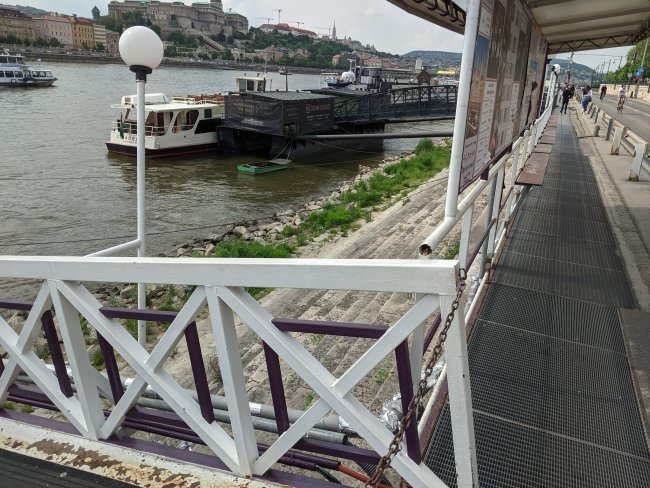
For the third time I walked through two other Viking ships. When I reached shore I once again headed north on the sidewalk toward Parliament. This time I got a little farther before I tripped on a steel ramp that one of the dinner cruises had constructed over the sidewalk. A young lady whose job was to welcome people to the cruise asked me if I was OK. I got up as quickly as I could and assured her that I was fine. She blurted out, "This happens all the time!"
If I had a litigious bent, I might have pulled out my recorder, pressed a couple of buttons, and asked her to repeat that. Instead, I continued walking at a slightly reduced pace.
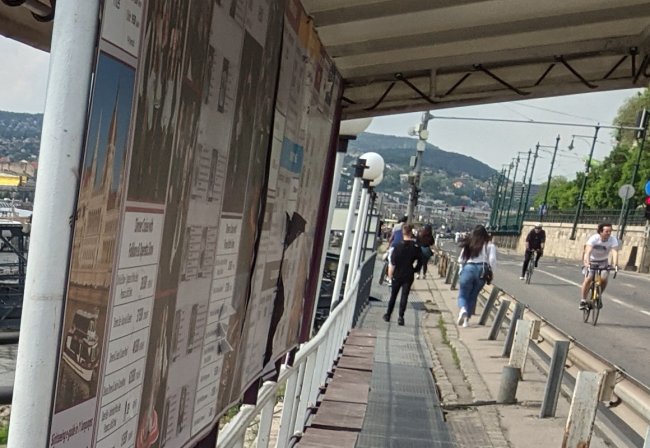
I had landed on the heels of both hands and my left knee. The hands were only slightly scraped; there was no bleeding. My knee hurt a little, but not enough to make me limp. My dominant concern was that it might slow me up on the return trip.
The sidewalk finally petered out. I moved to the east a block or so and then turned back to the north to walk on a sidewalk along a city street. As I neared the grounds of Parliament I encountered more and more people. On this entire adventure I saw several thousand people, no more than a half dozen of whom were wearing Covid masks.
Eventually, I was required to cross over a temporary (?) two-way divided pedestrian bridge that was shaped like the top half of a hexagon.[4] The steel bridge was the only way to cross one of the streets that was being used in the bike race, which had begun at noon. Waiting to cross over the bridge was a line of approximately fifty people, some of whom were carrying bicycles or e-scooters. We had to climb up fifteen or twenty steps, walk for about fifty feet above the street, and then climb down fifteen or twenty steps. Occasionally two thin people walked side-by-side, but for the most part we proceeded in single file. It took me at least ten minutes to get across. I doubt that Google Maps had accounted for this disruption.
By the time that I reached the other side of the bridge, I had decided to scuttle the Parliament tour even though I had already paid for it. The last thing that I needed was to miss the ship's first departure and to need to figure out how to rejoin the cruise in Vienna.
That was about the time that I realized I had left my camera in my stateroom. Perhaps that was lucky. If I had brought it, I would have strapped it around my neck. It may well have been damaged in the fall. That, on the first real day of a long vacation, would really have been a disaster. I also might have reached for it as I fell, which probably would have kept me from breaking my fall with my hands. I might have broken my only pair of glasses—another possible catastrophe.
So, I resolved to make the best of a bad situation by walking around the luscious grounds behind the Parliament. I discovered the Visitor Center, which was where the tour was scheduled to begin, but I did not enter. It was absolutely as far away from the ship as was possible.
In the four years that I had owned my cellphone, a Pixel 2, I had taken perhaps five photos, most of them of one of the cats. I had little confidence in my ability to photograph anything very well with it, but I did have pretty good editing tools. I took thirty or forty photos of the area around the Parliament building before I found a place to sit down and rest. If you are wondering why I did not post any of these photos, you will need to wait for a subsequent page of this journal.
Seated within earshot of me was a middle-aged Italian lady with a group of younger people. She did most of the talking. I was pleasantly surprised that I could understand a high percentage of what she said to them. If I had thought of recording them, I would have.
While I was sitting there my pants felt a little wet on my left leg. I also noticed that the blue jeans that I was wearing were darker in an area just above my knee. Evidently the scrape was more serious than I had estimated.
I decided to walk back to the ship and treat my wound. I was pretty sure that I had seen one or two adhesive bandages in my shaving kit. I wondered if my bottle of New-Skin was still there, and if the bandages, which were certainly at least five years old, were still serviceable.
The walk back to the ship took me about forty-five minutes. The line at the pedestrian bridge was much longer than it had been when I crossed in the other direction.
On the ship before supper: My first priority upon arriving at the ship was to appraise and treat my wound. It was only about the size and shape of a dime that had been flattened by a train. It was not bleeding profusely, but a fair amount of blood had been absorbed by my jeans. There was indeed a little bit of New-Skin in my shaving kit. I washed off the wound and applied bacitracin and a coating of new skin. I could not see any bleeding, but obviously at least one layer of skin had been removed. I waited for a while to see if it was still bleeding. I then coated it with another layer of New-Skin. I found two Band-Aids in my shaving kit, but I decided to save them for an emergency. I trusted the New-Skin to deal with the immediate issue.
Supper was not scheduled until 7 o'clock. I put on the same pair of jeans that I had worn on my star-crossed trek to Parliament. If the wound began to bleed again, I did not want to stain my only other pair. Besides, they were only slightly discolored. I doubted that anyone would notice, and what if they did? I wasn't running for president of the cruise.
By 5:00 I had looked at the photos on my phone. Most of them were very bad. Age has made my hands too shaky for a flimsy camera like a phone's. I also found it difficult to hold the thing by the edges. I sent the photo of the ship near which I fell to my laptop via e-mail and left the rest to worry about later..
At about 5:30 I made my way to the Sun Deck to photograph the ship's departure. As I passed the reception desk I saw Martijn the Hotel Manager poring over some computer reports. He seemed a little frantic.
At this point two Viking ships separated us from the land. All three were motionless and within a few feet of one another, clearly attached in some way. A couple of members of our crew were standing around in the middle of the Sun Deck on the side facing the land. One of them was holding a walkie-talkie of some sort. He listened more than he talked. A member of the crew of the adjoining ship, Viking Rinda, was stationed immediately opposite the two guys from Viking Vili.
At 6:05, twenty minutes after our published time of departure, Martijn's voice could be heard over the ship's intercom.[5] He read a rather long list of room numbers and sternly requested that a representative of each room report to Guest Services. About ten minutes later he made a similar announcement that contained only two room numbers. At 6:25 the man with the walkie-talkie finally received word that it was time to depart. He spoke with the man from Viking Rinda, and in a few seconds the Viking Vili was detached and moving.
The ship accelerated upstream very slowly. The light was superb for taking photos, and at the beginning the slow speed made it very easy to take quite a few photos with different zoom settings.
The captain certainly knew about the construction on the Chain Bridge. The ship sailed right underneath it. I was shocked that the distance between the small antennae on the wheelhouse and the bottom of the wrapping of the bridge was no more than a few inches.
I was thrilled by the view we got of the Parliament building. I took a lot of shots of it and its surroundings. After all, Viking has almost adopted it as its symbol. As the Parliament building disappeared from view, I put the cap on my camera's lens, turned off the camera's power, and went down the stairs to my cabin.
Supper with the Barkes: I changed into my black slacks, socks, and shoes for supper. I then ascended the stairs to the restaurant. I chose a spot in the middle. The views were pretty good, but I had spent the last half hour concentrating on the scenery.
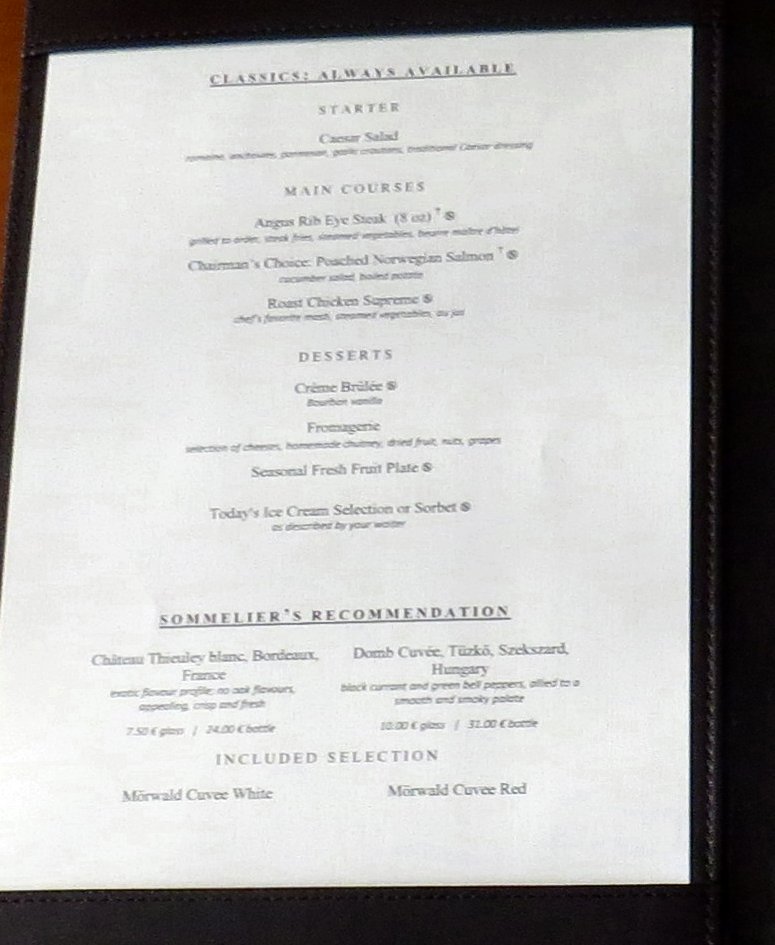
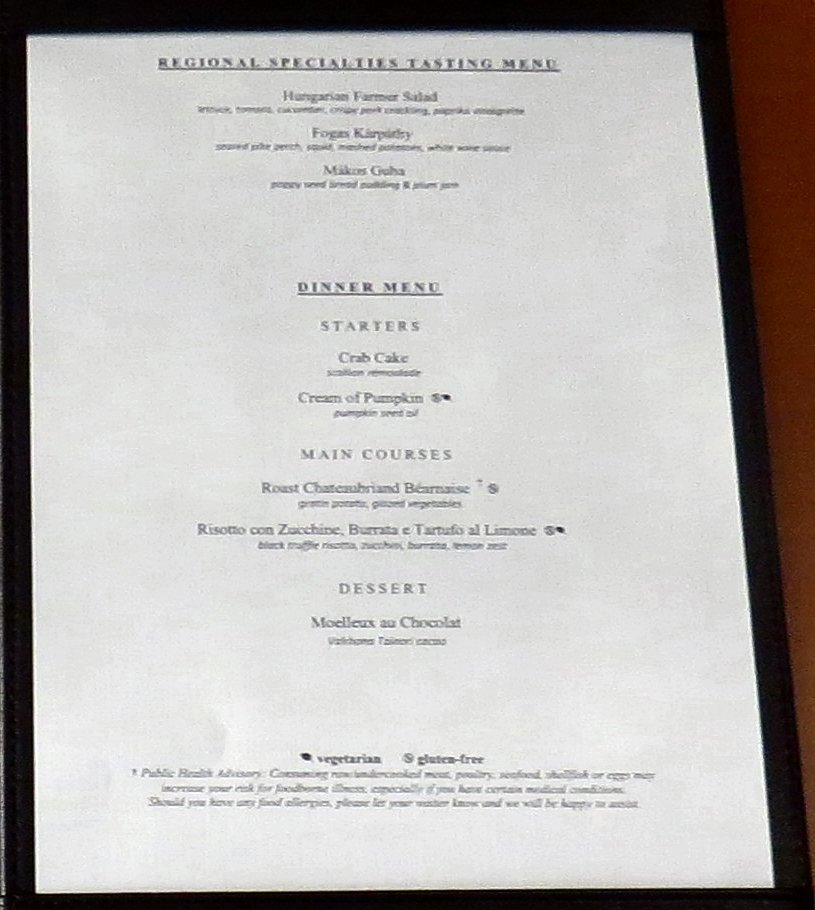
The waiter had just brought me a glass of wine and a menu when a British couple, Mike and Vivienne Barke, asked if they could join me. My answer was an enthusiastic affirmative. The waiter quickly brought them wine and menus. We all ordered at the same time. I chose the Caesar Salad, Chateaubriand with potatoes, and a sorbet. Vivienne's order was exactly the same. Mike had some kind of fish.
They asked me where I was from and I answered "Connecticut, in New England". They said that they were British. I told them that I had only been to England once, in 1990, I explained that I had won a story contest,[6] and the prize was a two-week trip for Sue and me to England. They naturally asked me where we went. When I mentioned York, they said that they live north and east of York.
I was very surprised by this. The further north that we got, the more trouble that we had understanding the people whom we encountered. I had no trouble understanding Mike or Vivienne. I asked them where specifically they lived. They said that they resided in a port city on the Tyne river called Newcastle.
I was gobsmacked. "Newcastle!" I exclaimed. "Vera is my favorite television show." They both lit up at this revelation. Mike, as it happened, was once filmed in the background of a scene in one of the episodes that was shot right in their neighborhood.
At about this time our food arrived. Vivienne had to return her plate because the potatoes were ice cold. Surprisingly, mine were quite hot. The waiter corrected the problem with Vivienne's in a matter of just a few minutes. The meal itself was enjoyable. I am not sure that I had ever eaten Chateaubriand before. However, the best thing about that supper—and the whole day—was the conversation.
I asked them what they had done in the afternoon. They said that they had walked across the bridge and then they had continued hiking in Buda. I was pretty impressed with their evident stamina.
I admitted that my afternoon had been a complete bust. I may have forgotten to mention that I face-planted and bled all over my blue jeans.
They asked me what my story was about, and I explained it as quickly as I could. They seemed to be amused by my recounting.
Vivienne revealed that Mike, who before his retirement taught geography at the University of Northumberland, had recently published a book. When I asked him what it was about, he described it as a history of the Tyneside area based on maps, which were his specialty. I told him that I thought that I would find that interesting.
The Barkes had traveled extensively in Europe and the United States. Mike had even taught for a year in Dar es Salaam, Tanzania. He had more problems with the monkeys that occasionally invaded the classrooms there than with inattentive students. I found it both sad and incredible that they did not get an opportunity to go on safari in any of the country's incredible national parks.
I told them about our visit to several parks in 2015.[7] The wine had erased from my memory the names of some of the parks involved, but I did take a few minutes to describe the encounters with the chimpanzees during our stay at Greystoke Lodge in Mahale Mountains National Park.
They asked me if I was familiar with any of the other British detectives on television. I think that they were astounded that I had seen all of the Morse and Lewis episodes and all of the Endeavour episodes except the first one.
They said that there was also a show about murder in English villages. I knew immediately that they were talking about Midsomer Murders. I ventured the opinion that the ones written by Anthony Horowitz in the first couple of seasons were by far the best, but I did rate season #20, the one most recently shown in the U.S., as better than #19.

I told them about the money-raising show that was on public television in the U.S. in which the actors talked about the shows. It was titled "20 Things to Do in Midsomer…Before You Die". One segment was about the outrageous murder weapons that have been used over the years. I told them that my favorite one was when the owners of a herd of dairy cows were trampled to death by their cows who were slowly stampeding inside the structure in which they customarily were fed. They also mentioned some favorites, but I have forgotten which ones they cited.
I opined that the mystery shows in the U.S. were less interesting than British ones because there were so many guns in the country. Our first reaction was always to ask why the killer didn't just shoot the victim. I admitted to liking Elementary, which was very different from the British update of the Sherlock Holmes saga, Sherlock. I found them equally enjoyable.
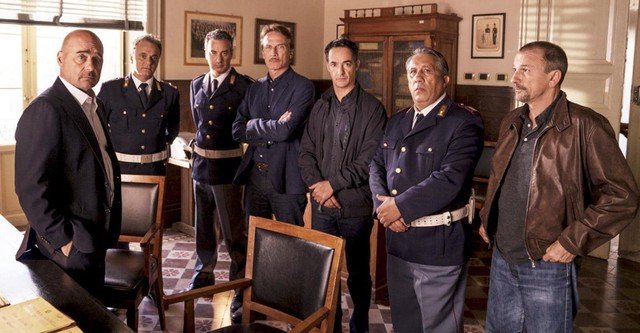
Then Mike asked me if I had ever heard of the Italian detective named Montalbano. He was definitely floored by my claim that I had seen all thirty-nine Commissario Mantalbano movies. I explained about my subscription to Mhz Choice, the streaming service for European TV shows, especially mysteries, with English captions. Mike said, "I really envy you." I didn't have the heart to mention that I had also read three of the Montalbano novels, two in Italian.
I explained that our tour guide in Sicily[8] had promoted the Montalbano novels and television shows, which the Italians called fiction. The Barkes had a good story about Sicily, too. Evidently Vivienne did all of the driving on this and all of their other trips. They found themselves on a road that narrowed and then lost its paving. They drove on it for a considerable distance, and then, without warning, it just ended at a barrier.
We were the last to leave the dining room. When I returned to my stateroom I checked to see if it had bled any more. It did not appear so. I uploaded my photos and my recordings to my laptop. All told, I took ninety-two photos with my camera, a little more than half of them on the bus.
I took a shower and applied bacitracin and New-Skin to the wound. I then sent the following email to Sue about my new "Geordie" friends, turned off the lights, and fell asleep.
Today was a terrible day. I won't bother you with the details.
Supper was incredible. A couple from England, Mike and Vivienne, asked to sit with me. They eventually told me that they were from Newcastle. I told them that we were both big Vera fans. Mike had a part (unscripted) in one episode when they were filming near their house. They both know the writers.
We talked and talked about Morse, Endeavour, Lewis, and Wallander, Tanzania (Mike taught Geography there), Sicily, and dozens of other things. It was truly magical.
What a day!
[1] The QuietVox unit consisted of a fat cigar-shaped receiver and a neckstrap. It ran on batteries; a charger was on the counter in each stateroom. A thin audio cable could be plugged into the main unit. The other end of the cable was an earpiece that fit in the left ear. Each tour guide had a small microphone headset and a unit that broadcast what he or she said. At the beginning of the excursion the receivers were placed in contact with the transmitter to set them to the proper channel. They seemed to work flawlessly.
[2] I am pretty sure that this was what István said, but actually Pavlics was twenty-eight years old in 1956.
[3] I probably should have gone to the market. István said that you could buy almost anything. I subsequently had a lot of difficulty finding a store that sold a few things that I forgot to bring.


